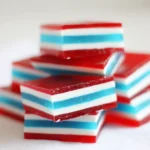Introduction: A Bite of Swiss Tradition
Contents
- 1 Introduction: A Bite of Swiss Tradition
- 2 Why You’ll Love This Gipfeli Recipe
- 3 What is Gipfeli?
- 4 The History of Gipfeli: From Traditional Swiss Bakeries to Modern Kitchens
- 5 Ingredients You’ll Need
- 6 Kitchen Equipment to Have on Hand
- 7 Step-by-Step Instructions for Making Gipfeli
- 8 Expert Tips for Perfectly Flaky Gipfeli
- 9 Gipfeli Variations You Can Try
- 10 Serving Suggestions
- 11 Storage and Freezing Tips
- 12 Common Issues and Fixes When Making Gipfeli
- 13 FAQs About Gipfeli Recipe
- 14 Gipfeli Recipe: Swiss Breakfast Pastry
- 15 Conclusion: Time to Try This Delicious Swiss Treat!
- 16 Suggested Pastry Recipes to Explore
If you’ve ever visited Switzerland or have a soft spot for buttery pastries, you’ve likely come across Gipfeli a Swiss breakfast staple. This crescent-shaped pastry holds a special place in Swiss culture, where mornings aren’t quite complete without it. While Gipfeli may resemble its French cousin, the croissant, it offers a unique twist in texture and taste. Whether paired with a warm cup of coffee or eaten on the go, Gipfeli is a simple pleasure that’s hard to beat.
The charm of Gipfeli lies in its versatility. You’ll find it plain, filled with chocolate, or stuffed with savory options like ham and cheese. Learning how to make Gipfeli at home is your ticket to baking a pastry that’s crisp on the outside, soft on the inside, and utterly satisfying. Ready to dive into a flaky adventure? Let’s get started!
Why You’ll Love This Gipfeli Recipe
Imagine waking up to the smell of fresh, buttery pastry wafting through your home—sounds dreamy, right? This Gipfeli recipe is perfect for breakfast, brunch, or even a quick snack. Here’s why you’ll fall in love:
- Flaky Layers: Thanks to the lamination process, you get those satisfying layers that melt in your mouth.
- Easy Customization: Whether you want sweet or savory, this recipe has you covered with filling options like chocolate or cheese.
- Beginner-Friendly: Don’t worry if you’ve never laminated dough before! I’ll guide you through each step, so your Gipfeli turns out perfectly every time.
Trust me once you make gipfeli recipe from scratch, store-bought versions won’t stand a chance. With some patience and love for buttery goodness, you’re about to become a pastry pro.
What is Gipfeli?
At first glance, Gipfeli might seem like Switzerland’s version of a croissant, but there are key differences. While croissants are known for their buttery, ultra-flaky texture, Gipfeli is slightly denser and less buttery, giving it a heartier bite. Its crescent shape is similar, but it’s typically smaller and firmer.
gipfeli recipe is a popular breakfast food in Switzerland, where it’s enjoyed plain or stuffed with fillings. Unlike the croissant’s luxurious buttery overload, Gipfeli offers a balanced texture that’s crisp on the outside and soft on the inside. The dough is laminated (folded with butter), but it doesn’t require the extensive folding and resting time of a croissant. This makes it a quicker option for home bakers looking for delicious homemade pastries without all the fuss.
Whether you’re new to Swiss cuisine or already a fan of European baked goods, gipfeli recipe is a treat that deserves a spot on your breakfast table.
The History of Gipfeli: From Traditional Swiss Bakeries to Modern Kitchens
gipfeli recipe has humble beginnings rooted in Swiss bakeries, where it was traditionally made fresh each morning and sold alongside coffee and tea. Its name comes from “Gipfel,” meaning peak or summit, which reflects its crescent shape. While the exact origins of Gipfeli are debated, many believe it was inspired by Austrian or Hungarian pastries.
In the 19th century, Gipfeli became a staple of Swiss breakfasts and quickly spread to neighboring countries. Swiss households began baking them at home, tweaking recipes and adding fillings to suit local tastes. Over time, different versions emerged, including Nussgipfel (hazelnut-filled) and Schoggi-Gipfeli (chocolate-filled). Today, Gipfeli can be found everywhere from artisan bakeries to supermarkets, proving its enduring popularity.
Modern kitchens have embraced the simplicity of making gipfeli recipe at home, and with this recipe, you can enjoy the same authentic flavors without hopping on a plane to Switzerland.
Ingredients You’ll Need
Here’s a breakdown of everything you’ll need to create perfect Gipfeli. The key ingredients work together to form those signature layers and rich flavors.
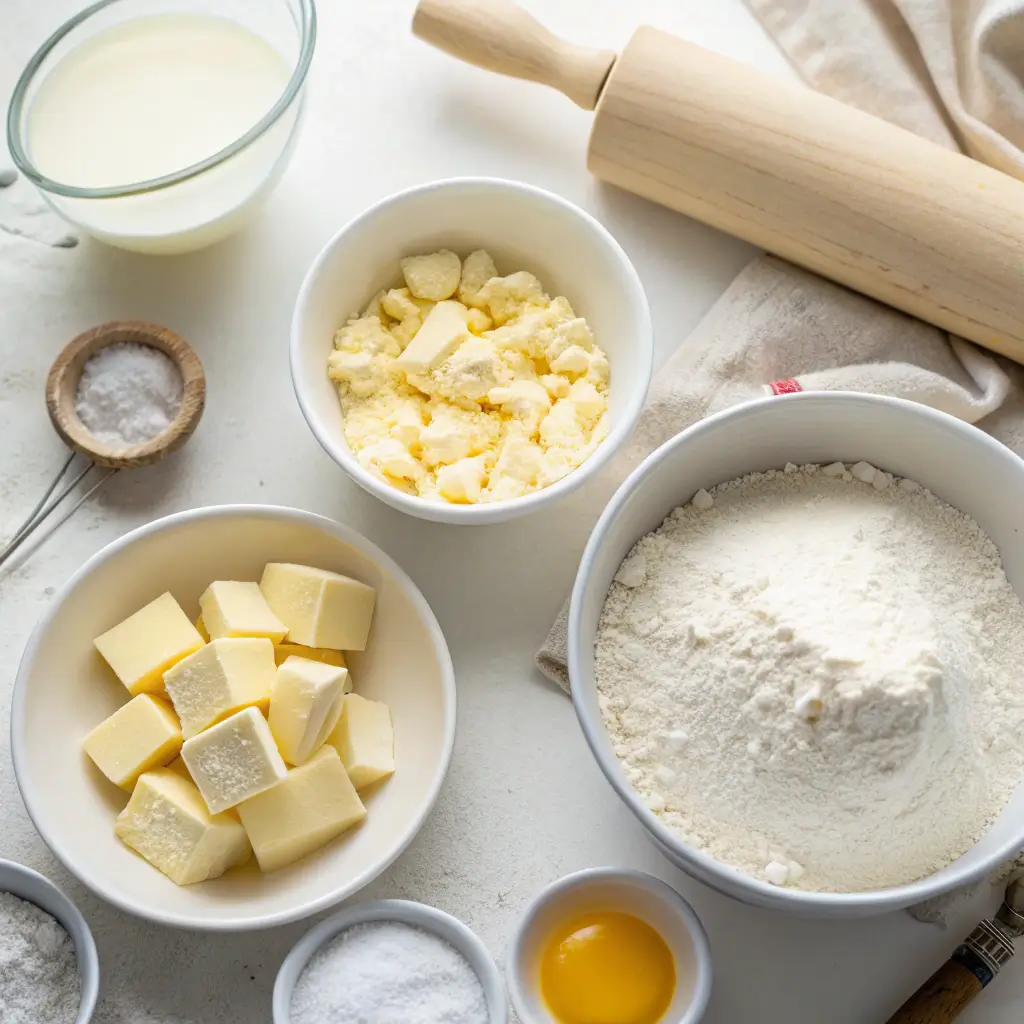
| Ingredient | Amount | Purpose |
|---|---|---|
| All-purpose flour | 500g | Base for the dough, providing structure |
| Warm milk | 250ml | Activates the yeast and hydrates the dough |
| Sugar | 50g | Adds a hint of sweetness |
| Active dry yeast | 7g (1 packet) | Helps the dough rise and become fluffy |
| Salt | 1 tsp | Balances flavors |
| Unsalted butter (cold) | 250g | Creates the flaky layers through lamination |
| Egg (beaten) | 1 | For the egg wash, creating a golden crust |
Optional Fillings
- Sweet: Chocolate, Nutella, or jam
- Savory: Ham and cheese, spinach and feta
Kitchen Equipment to Have on Hand
You don’t need fancy equipment to make Gipfeli, but having these tools will make your life easier:
- Mixing bowl: For combining ingredients and kneading the dough
- Rolling pin: Essential for rolling and folding the laminated dough
- Baking sheet: To bake your gipfeli recipe to golden perfection
- Parchment paper: Prevents sticking and ensures even baking
- Pastry brush: For applying the egg wash
- Plastic wrap: To cover and rest the dough during the proofing process
With these tools ready, you’ll be set to tackle the recipe like a pro.
Step-by-Step Instructions for Making Gipfeli
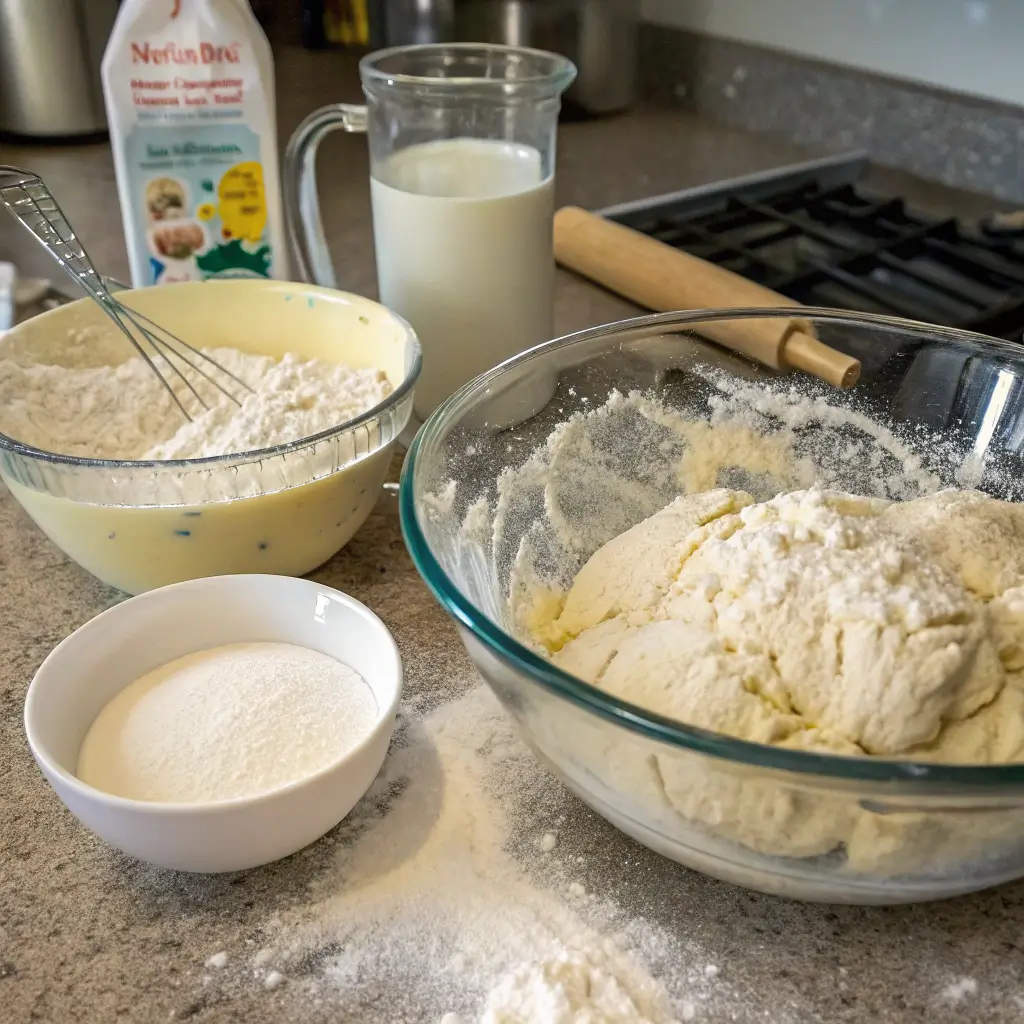

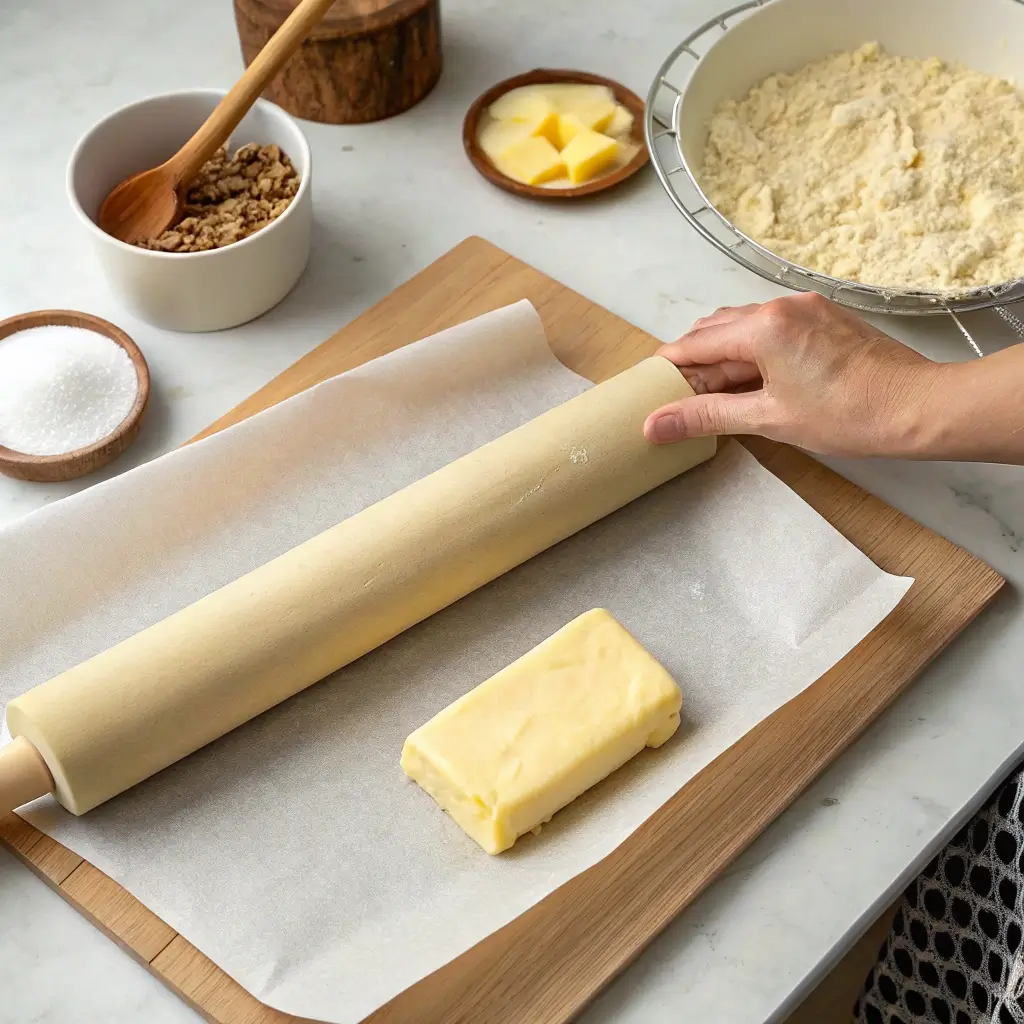
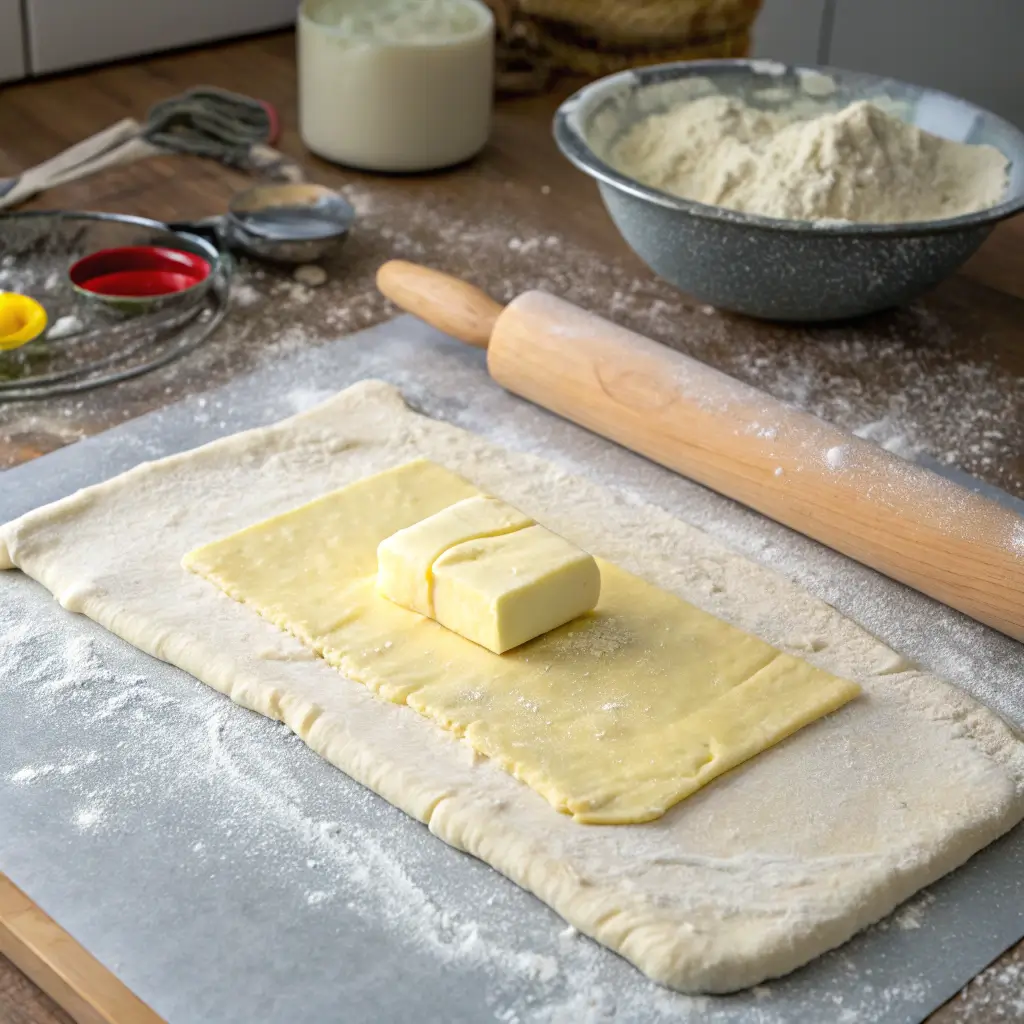
1. Mixing and Kneading the Dough
Start by activating the yeast. In a small bowl, mix the warm milk, sugar, and active dry yeast. Let it sit for 5-10 minutes until frothy—this signals the yeast is alive and ready to work its magic.
In a large mixing bowl, combine the flour, salt, and the activated yeast mixture. Mix until a shaggy dough forms, then turn it onto a floured surface and knead for about 8-10 minutes until smooth and elastic. Don’t skip the kneading—it’s crucial for developing gluten, which will give your gipfeli recipe structure and chew.
2. Resting the Dough
Place the dough in a greased bowl, cover it with plastic wrap, and let it rest for 1 hour or until it doubles in size. This is where patience pays off, as the resting time allows the yeast to do its thing.
3. Preparing the Butter Block
Cold butter is key to creating those flaky layers. Place the butter between two sheets of parchment paper and gently pound it with a rolling pin until it forms a rectangular block about ½ inch thick. Keep the butter chilled until you’re ready to laminate the dough.
4. Laminating the Dough for Layers
Roll out the dough into a large rectangle, about twice the size of your butter block. Place the butter in the center, fold the dough over it like a letter, and seal the edges. Roll the dough out again and fold it into thirds. Repeat this process three times, chilling the dough for 30 minutes between each fold.
This step might seem extra, but trust me—it’s worth it for the flaky layers!
- Learn more about laminating techniques to master baking yeast-based dough like a pro.
Expert Tips for Perfectly Flaky Gipfeli
Achieving perfectly flaky gipfeli recipe comes down to mastering a few key techniques. First, use cold butter. This step isn’t optional if you want those golden layers to form. Cold butter ensures that the dough separates properly during baking, creating the signature flakiness.
Second, pay attention to dough consistency. It should be smooth and elastic after kneading. If it’s too sticky, add a bit more flour. If it’s too dry, a splash of warm milk will help.
When laminating, chill the dough between folds. This allows the butter to firm up, preventing it from melting into the dough prematurely. Remember to work quickly when rolling out the dough, especially if your kitchen is warm. Warm butter can be a disaster for layers, so keep everything cool.
Lastly, don’t over-handle the dough. Overworking it can result in tough Gipfeli. Treat it gently, and you’ll be rewarded with light, airy layers.
This is where the magic happens, so trust the process and follow these steps carefully. You’ve got this!
Gipfeli Variations You Can Try
One of the best things about gipfeli recipe is how customizable it is. Whether you’re in the mood for sweet or savory, there’s a variation for every craving:
Sweet Options
- Chocolate-filled (Schoggi-Gipfeli): Place a small piece of dark chocolate or a spoonful of Nutella on the dough before rolling it into a crescent.
- Almond Paste (Mandelgipfel): Spread a thin layer of almond paste for a nutty, sweet filling.
- Jam-Filled: Raspberry or apricot jam works wonders, adding a fruity surprise.
Savory Options
- Ham and Cheese: Layer thin slices of ham and Swiss cheese before rolling for a hearty breakfast option.
- Spinach and Feta: Sautéed spinach and crumbled feta make a delicious filling, perfect for brunch.
- Cream Cheese and Chives: A creamy, savory twist that’s great for any time of day.
Feel free to mix and match. Want to experiment? Try half the batch with chocolate and the other half with ham and cheese. It’s like getting two breakfasts in one!
Serving Suggestions
gipfeli recipe is incredibly versatile, making it the star of any breakfast spread. Here are some delicious pairings and serving ideas to elevate your experience:
- Coffee or Swiss hot chocolate: A warm beverage is practically mandatory when enjoying Gipfeli. The pastry’s buttery layers soak up the flavors beautifully.
- Jam and butter: For a simple yet satisfying treat, slather on some homemade jam or fresh butter.
- Eggs and cheese: Turn gipfeli recipe into a breakfast sandwich by slicing it open and filling it with scrambled eggs and cheese.
- Fruit and yogurt: Pair with a bowl of fresh berries and yogurt for a balanced breakfast.
Whether you’re hosting brunch or enjoying a lazy weekend morning, gipfeli recipe fits right in with other perfect breakfast options.
Storage and Freezing Tips
gipfeli recipe tastes best fresh out of the oven, but don’t worry—you can store leftovers and enjoy them later without losing much of that signature flakiness.
Storing Leftovers
Place cooled gipfeli recipe in an airtight container and store them at room temperature for up to 2 days. For longer storage, keep them in the fridge, but make sure to warm them up before eating to restore their texture.
Reheating Tips
To bring back that just-baked crispiness, reheat gipfeli recipe in a preheated oven at 350°F (175°C) for 5-7 minutes. Avoid using the microwave, as it can make them soggy.
Freezing Instructions
You can freeze either unbaked or fully baked Gipfeli:
- Unbaked: Shape them, then freeze on a baking sheet. Once solid, transfer to a freezer bag. Thaw overnight in the fridge before baking.
- Baked: Cool them completely, then freeze. Reheat in the oven directly from frozen for 10-12 minutes.
Whether you freeze them baked or unbaked, you’ll have authentic Swiss pastries ready anytime you crave them.
Common Issues and Fixes When Making Gipfeli
Even experienced bakers face hiccups, but don’t worry—I’ve got you covered with solutions to common gipfeli recipe problems.
1. Soggy Dough:
- Issue: The dough turns out too wet or dense.
- Fix: Make sure to use cold butter and chill the dough between folds. Warm butter can seep into the dough and cause sogginess.
2. Uneven Layers:
- Issue: The gipfeli recipe lack defined layers.
- Fix: Roll the dough evenly and avoid pressing too hard during lamination. Chill the dough if the butter starts to soften.
3. Under-Proofed Dough:
- Issue: The gipfeli recipe don’t rise properly and are dense.
- Fix: Ensure your dough has enough time to proof in a warm, draft-free environment. If your kitchen is cold, try proofing in the oven with just the light on.
These simple adjustments will make all the difference, ensuring your gipfeli recipe turn out beautifully every time.
FAQs About Gipfeli Recipe
What is the difference between a croissant and a Gipfeli?
What is the Swiss version of a croissant?
What is a Mandelgipfel?
Gipfeli Recipe: Swiss Breakfast Pastry
A buttery, crescent-shaped Swiss pastry, Gipfeli is similar to a croissant but with a denser texture and less butter. Enjoy them plain or stuffed with sweet or savory fillings.
- Prep Time: 100 minutes
- Cook Time: 20 minutes
- Total Time: 2 hours
- Yield: 12 Gipfeli 1x
- Category: Breakfast
- Method: Baking
- Cuisine: Swiss
- Diet: Vegetarian
Ingredients
- 500g all-purpose flour
- 250ml warm milk
- 50g granulated sugar
- 7g active dry yeast (1 packet)
- 1 tsp salt
- 250g cold unsalted butter, cut into small pieces
- 1 egg (beaten, for egg wash)
Optional Fillings:
- Sweet: Chocolate, Nutella, almond paste, jam
- Savory: Ham and cheese, spinach and feta
Instructions

- Activate the yeast: In a small bowl, combine warm milk, sugar, and yeast. Let it sit for 5-10 minutes until frothy.
- Mix and knead the dough: In a large mixing bowl, combine flour, salt, and yeast mixture. Knead on a floured surface for 8-10 minutes until smooth.
- Rest the dough: Place dough in a greased bowl, cover with plastic wrap, and let it double in size (about 1 hour).
- Prepare the butter block: Flatten cold butter between two sheets of parchment paper into a rectangle. Chill until ready to laminate.
- Laminating: Roll out the dough into a large rectangle, place the butter block in the center, and fold the dough over it like a letter. Roll and fold the dough three times, chilling for 30 minutes between each fold.
- Cut and shape: Roll out the laminated dough and cut into triangles. Roll each triangle into a crescent shape.
- Proof: Place Gipfeli on a baking sheet lined with parchment paper and let proof for 45 minutes.
- Apply egg wash: Brush the tops with beaten egg for a golden finish.
- Bake: Preheat oven to 375°F (190°C) and bake for 15-20 minutes until golden brown.
- Cool and serve: Let cool slightly before serving. Enjoy plain or with your favorite filling!
Notes
- Use cold butter for proper lamination.
- Be patient during resting and chilling stages for best results.
- Experiment with different fillings to suit your taste.
Nutrition
- Serving Size: 1 Gipfeli
- Calories: 280
- Sugar: 5g
- Sodium: 150mg
- Fat: 14g
- Saturated Fat: 8g
- Unsaturated Fat: 5g
- Trans Fat: 0g
- Carbohydrates: 32g
- Fiber: 1g
- Protein: 6g
- Cholesterol: 45mg
Keywords: Gipfeli recipe, Swiss breakfast, laminated dough, buttery crescent, Swiss pastry
Conclusion: Time to Try This Delicious Swiss Treat!
You’ve got all the steps, tips, and inspiration to master gipfeli recipe at home. With each fold of buttery dough, you’re crafting a slice of Swiss tradition that’s perfect for breakfast or an afternoon treat. Sure, it takes a bit of patience, but the end result is worth every second.
So, roll up your sleeves, preheat that oven, and get baking. Whether you’re filling them with chocolate, ham, or keeping it plain, you’re about to create a breakfast worth waking up for. Share your success with family and friends and don’t forget—you can always try different fillings to mix things up.
Check out other flavored bread variations and let your inner baker shine!
Suggested Pastry Recipes to Explore
If you loved this Gipfeli recipe, here are a few more pastries you’ll want to try next:
- Light and fluffy pastries like Madeleine cookies.
- Holiday desserts and treats to bring warmth to any gathering.
- Authentic Swiss pastry guide for perfecting your breakfast game.
Happy baking!








